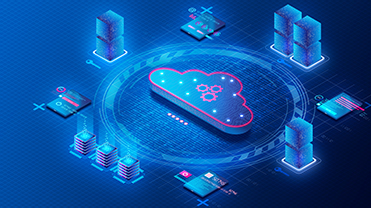How serverless architecture is changing
the way we build applications
In the ever-changing landscape of cloud-based app development, a revolutionary concept has emerged — serverless architecture. This novel approach empowers developers to harness the power of the cloud eliminating the need for infrastructure management, enabling them to focus on what they do best – creating exceptional applications.
Previously, companies relied on third-party providers for server space or maintained dedicated servers to run their applications. This entailed significant responsibilities beyond core application development, including tasks like server resource management, traffic management, disaster recovery, and ensuring security for 24×7 application availability. The advent of serverless architecture empowered developers to move away from these operational tasks, freeing them from managing servers, virtual machines, and other low-level infrastructure elements.
Serverless architecture represents a cloud computing model where the underlying infrastructure is managed by the cloud provider, allowing developers to concentrate on deploying code as concise, event-driven functions. The term “serverless” doesn’t indicate the absence of servers; instead, it signifies that developers are liberated from tasks like managing server provisioning, scaling, or maintenance. The cloud provider seamlessly handles resource allocation and scaling based on the incoming workload and events.
Exploring serverless architecture with key examples
Serverless architecture is popular, particularly for event-driven and highly dynamic applications, owing to its simplicity, scalability, and cost-effectiveness. Ideal for developing microservices, REST APIs, data processing pipelines, and real-time applications, this architecture is well suited for asynchronous, stateless apps, and use cases with unpredictable demand surges, such as batch processing, monitoring database changes, handling data streams, implementing chatbots, managing scheduled tasks, and executing business logic.
Of these, Function-as-a-Service (FaaS) stands out as a widely adopted serverless architecture, operating on an event-driven model, executing code in stateless, ephemeral containers triggered by events. This approach offers developers precise control, enabling them to deploy applications through APIs managed by FaaS providers. Many major public cloud providers offer FaaS solutions, including AWS Lambda, Azure Functions, Google Cloud Functions, and IBM Cloud Functions. Alternatively, organisations can also implement their own FaaS using open-source platforms like Red Hat OpenShift Serverless.
Numerous industry giants including Coca-Cola, Netflix, and Bosch have leveraged serverless architecture to enhance application performance, streamline processes, and scale applications. For example, Coca-Cola applied serverless architecture to its “Freestyle” soda dispensers, which allow customers to customise their beverage choices. They use AWS Lambda for real-time telemetry data processing and reporting to ensure machine availability and efficiency. Streaming giant Netflix is also known for using serverless architecture extensively on their platform, employing AWS Lambda for various functions like user authentication, video transcoding, and data processing. This allows them to scale according to demand while only paying for the compute resources utilised. On the smart devices side, Bosch TTNA, while developing a smart HVAC solution with remote monitoring, analysis, and troubleshooting capabilities, sought a system capable of managing fluctuating workloads with minimal infrastructure management effort. To achieve this, they incorporated AWS Lambda as a core service for their cloud-connected heat pump system. This strategic choice allowed Bosch TTNA to delegate backend and infrastructure management to AWS, enabling them to concentrate on driving application innovation.
Recognising when to deploy serverless architecture
Serverless architecture excels when used with chatbots, Internet of Things (IoT), data stream processing, and backends. While it proves powerful for numerous cloud-based applications, it is not a one-size-fits-all solution. Here are some vital areas where serverless architecture shines:
Event-driven applications: If an event-driven app responds to various triggers such as HTTP requests, database changes, file uploads, or real-time user interactions, serverless architecture can efficiently handle these events and execute code in response.
Fluctuating workloads: In cases where an application encounters variable workloads marked by unpredictable peaks and valleys in traffic, serverless architecture can automatically scale to adapt to these demand fluctuations. This cost-effective scaling makes it a fitting choice for such applications.
Microservices Architecture: Serverless can be used to build microservices, which are small, standalone components of an application. When adopting a microservices architecture, serverless functions can serve as individual microservices, promoting modularity and flexibility.
Softdel revamped the existing AWS cloud application for a leading water heating solutions provider’s mobile app by re-architecting the backend into serverless microservices. This accelerated deployment, facilitating their swift market entry.
Frequent Updates: If an app requires frequent updates and code changes to enable deployment of new functions or updates, serverless architecture emerges as the preferred option.
Real-time data processing: Serverless architecture proves advantageous for swift responsiveness to incoming events in scenarios where an app requires real-time data processing, like in chat applications, real-time analytics, or IoT solutions.
Ecosystem and vendor support: Leading cloud providers offer comprehensive serverless platforms equipped with a wide ecosystem of services and tools. Organisations can effortlessly integrate serverless solutions into their established infrastructure by choosing serverless solutions from the same cloud provider in use.
The pros and cons of adopting serverless architecture
To streamline the adoption process, we’ve outlined the potential benefits and drawbacks associated with the utilisation of serverless solutions. This can empower decision-makers to make informed choices tailored to their specific business needs.
Advantages of serverless architecture
Scalability: Typically, applications demand higher resources during peak usage and lower resources during off-peak periods. With a serverless platform, the application will scale horizontally and vertically based on the performance monitoring need, and the entire process will be seamlessly managed by the service provider.
Language support: Serverless platforms support multiple languages, enabling users to code applications in their language of choice. For instance, AWS lambda function in JavaScript, Python, Java, C#, and more.
Availability: Service providers maintain uninterrupted application functionality, handling tasks like disaster recovery and backups internally. This consistent operation minimizes downtime, ensuring constant availability for users.
Security: In addition to serverless features, service providers offer certain security features to safeguard applications from potential attacks. For example, policies over AWS lambda functions ensure that they do not run all the time, ceasing after request processing, and they do not maintain cache memory, mitigating the risk of long-term attacks.
DevOps: Serverless architecture also simplifies complicated DevOps processes like scaling, monitoring, and deployment.
Disadvantages of serverless architecture
Stateless nature: Serverless functions operate in a stateless manner, limiting the ability to store data in the application cache. As a result, other storage services, often paid ones, are frequently needed to retain any information.
Rapid timeouts: A maximum execution time restriction exists for all serverless architecture. For instance, in AWS Lambda, the maximum execution time is 15 minutes, rendering it unsuitable for prolonged processes.
In today’s world of cloud-based applications, serverless architecture has become the new normal for application development, thanks to its simplicity, scalability, cost-efficiency, event-driven nature, and a host of other compelling advantages. And who doesn’t want highly responsive, cost-effective, and scalable applications, which lead to superior user experience and expedited time-to-market?
The future of cloud-based app development is serverless, and it beckons every decision-maker to explore and leverage its transformative potential.






